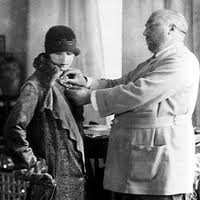 |
| Paul Poiret 1879 - 1944. This picture was taken in 1913. |
It was Paul Poiret who completely revoultionized the female shilouette and gave us the high waisted empire line dress. C'est magnifique! Poiret was to fashion as Picasso was to art. A head turner, mover and shaker. He was visionary.
 |
| Denise Poiret in her husband's iconic Kimono coat. 1911. |
This coat, OMG!! Chic, classy, way out and totally stroke-able beautiful. I must have one!!! I want one, I want one, I WANT ONE!!!!!!
Yet at the time, unbelievably critics didn't love it so much. I know!? But it was soooo new, sooooo in your face different - that it was shocking. I just think it's beautifully drool-able. What did Poiret do about his critics - well, he threw massive lavish parties and designed flamboyant window designs to bring even more attention to his lavish creations and it worked. Poiret knew his worth in marketing. Infact he was a marketing genius. He had his wife Denise (formerly Boulet) model his Kimono coat for fashion shoots photographed by the celebrated American artist and photographer Edward Steichen- something not commonly done before - his photos of Poiet's designs and gowns were published in the magazine Art et Decoration in 1911 are widely believed to be the first modern fashion photgraphs published. Poriet didn't stop there, he then went on to design a signature perfume, called 'Parfums de Rosine', named after his daughter and he was the first fashion house to do so. When he unveiled a new design or line, he would throw fatastic evening soiree's and extravagant balls making his designs the talk of the fashionable elite. He was a motivational machine in human form.
For Poiret his motivation and muse was his beloved childhood sweetheart and wife Denise, whom he married in 1905 an together they produced five children. Throughout most of his working life Poiret it can be said that he designed with only one woman in mind, his wife Denise.
In 1913 Poiret told Vogue "My wife is the inspiration for all my creations; she is the expression of all my ideals". It seems perplexing then that in 1928 they divorced in less than amicable circumstances. Madame Poiret kept many of the gowns her former husband designed for her and in 2005 they were bought by the Metroplitan Museum Of Art, in New York.
At the height of his fame Poiret designed clothes for women such as Peggy Guggenheim, Lillie Langtry, Josephine Baker, Isadora Duncan and Elsa Schiaparelli.
 |
| Poiret's Hobble skirt. He liked to boast with this design that 'He freed the bust but shackled the legs'. |
Poiret's once seemingly simplistic designs were now over worked and fussy. Poiret was out of fashion and business. In 1924 with his designs out of favour and over priced he spoke once more of Ms Chanel "What has she invented? Poverty de luxe". By 1929 Poiret's fashion House had closed with reminent dresses sold by their weight for rags. His decline into embarrassing poverty led him to become a street painter to local street cafes. Later in his life ill with Parkinson's disease Poiret died in 1944 and was forgotten in time. Even his funeral was paid for by an old friend Elsa Schiaparelli, the Italian fashion designer.
 |
| Model showing Poiret's draping gowns. |
 |
| Denise Poiret in Faune ensemble 1919. |
Personally even from a twenty first century view point, I find Poiret's designs refreshing and liberating. He was one of the founding designers responsible for freeing woman from their tight laced corsets and restricting boned gowns, then helped introduce the bra. He invited women of the era to brave the streets and even the mobs who booed and hissed at them for their new found body liberation. His Kimono coat is one of the most beautiful coat designs I have ever seen. His other memorable designs given to the world include the notorious Hobble skirt which caused public outcry, Harem pantaloons (of which recently there has been a big revival in stores), the sack dress, lampshade tunics, la garconne and his draping dress designs. His structual simplicity is the key to his designs and the gateway to leading other modernist designers. Without him where would designs be today? There may not have been the Flapper era, that boyish charm of simple yet bold empowering design. He broke the moulds of tailoring to introduce draping dresses, that "dressed a woman from afar" drawing on Greek influences. He helped bring the Oriental influence into modern Western clothing, making it chic and fashionable for society gals to wear. In 1911 he founded Artelier Martine, named after yet another daughter. It was a centre of academic fashion where young untrained women and girls were trained to express their own individuality in textile design for furniture and fashion textiles and wallpaper design. This was at a time when women were fighting for the vote in England. He was so ahead of his time. Free without constraints. Everything is an evolution and Poiret is a big marker on the vintage fashion timeline.
 |
| Denise Poiret 1913 in New York. |
 |
| The Kimono Coat. |
Poiret
 |
| Coat 1919. |
From the private collection of Denise Poiret - now at the Metropolitan Museum of Art, New York.






No comments:
Post a Comment